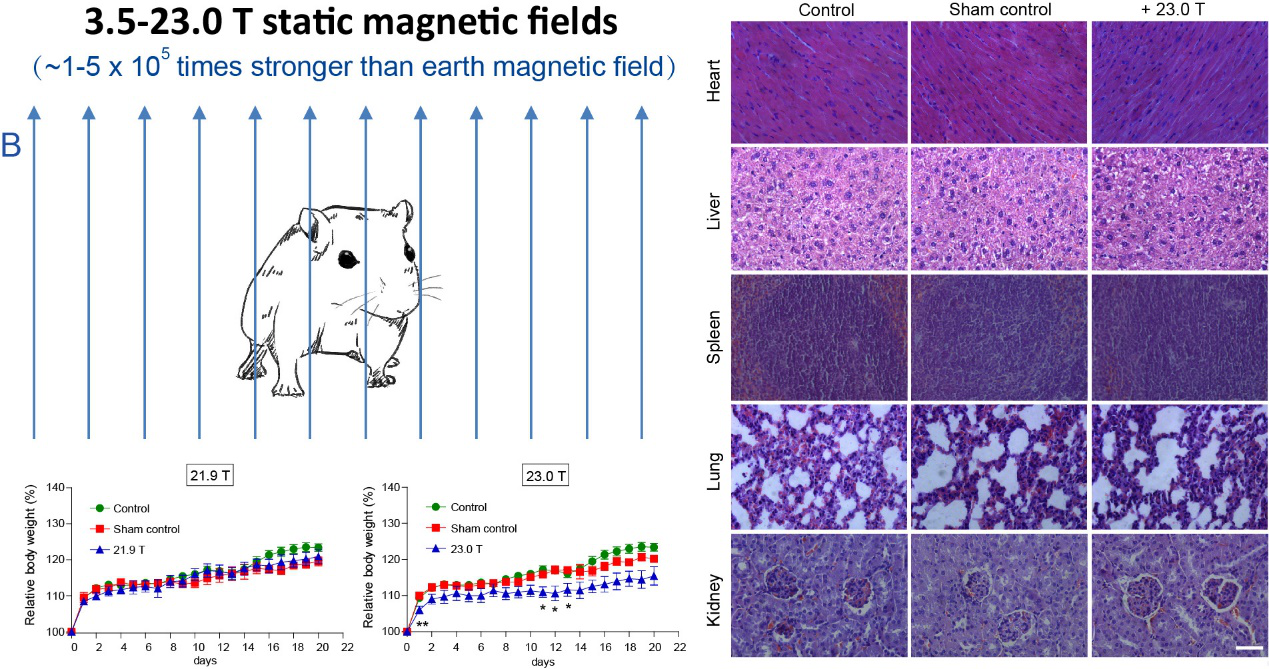Jul 12,2019|By
Have you ever imagined what would happen on you if exposed to high magnetic field?
A recent study may answer.
ZHANG Xin's group at High Magnetic Field Laboratory, Chinese Academy of Sciences (CHMFL) discovered that 2-hour exposure of 3.5-23.0 T high static magnetic fields (SMFs) does not obviously affect major organs, routine blood indicators, major parameters of liver and kidney functions, lipid metabolism and ion concentrations of normal mice.
In order to improve tissue resolution and imaging function, the SMF intensity used in Magnetic Resonance Imaging (MRI) for humans has increased from~0.5 T to 1.5 or 3.0 T in most hospitals.
In recent few years, not only 7 T MRI has been clinically approved, preclinical tests have also been performed in 9.4 T MRI. Moreover, research-type small-bore 21.1 T MRI has also been used in rodent brain imaging.
However, due to the relative shortage of magnets, the biosafety research of SMFs over 20 T is very limited, which is of great scientific and practical significance for development and clinical application of high-field MRI.
The researchers from Prof. ZHANG's group set up a platform to examine biological samples in high SMFs and systematically examined the effects of 3.5–23.0 T SMFs for their effects on mice.
They conducted some small-scale experiments to test the effect of 9-hour exposure of 3.7-24.5 T SMFs on Gastrointestinal Stromal Tumor tumor-bearing mice. They found that the tumor growth was inhibited.
Although most of the mice physiological and biochemical indicators were not significantly altered, they found that the mice livers were mildly affected.
Therefore, the researchers further reduced both magnetic field intensity and treatment time to test their effects on 112 normal mice.
They found that the major organs (heart, liver, spleen, lung and kidney), routine blood indicators, liver and kidney functions, lipid metabolism and ion concentrations were not obviously affected by 2-hour exposure of 3.5-23.0 T high SMFs.
The food consumption and body weight gain were affected to some extent by 23.0 T SMF, but not by 21.9 T SMF or below.
These results provide some positive references for developing high-field MRIs in the future. The research team is currently continuing working on the effects of these high SMFs on the mice nervous system, reproductive and developmental system etc.
The research was supported by the National Major Scientific and Technological Infrastructure Construction Project, the National Key R&D Program of China, National Natural Science Foundation of China, the Major/Innovative Program of Development Foundation of Hefei Center for Physical Science and Technology, and the CASHIPS Director’s Fund.
Link to the paper: Effects of 3.5–23.0 T static magnetic fields on mice: A safety study.
 |
|
3.5–23.0 T high SMF exposure for 2h is relatively safe on mice. The food consumption and body weight gain were affected to some extent by 23.0 T SMF, but not by 21.9 T or below. (Image by TIAN Xiaofei) |
Attachments Download: